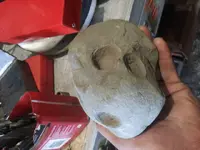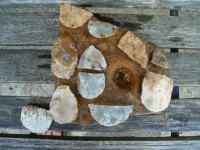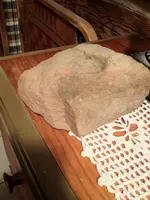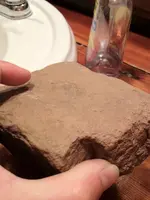You are using an out of date browser. It may not display this or other websites correctly.
You should upgrade or use an alternative browser.
You should upgrade or use an alternative browser.
??? found a few of these not sure what to think.
- Thread starter biggoldy
- Start date
NC field hunter
Silver Member
I'm more than sure that they are nutting stones, but odd. Nice! I have one small one that is cupped out deep on top and has a shallow cup on the back. If I'm not mistaken, Gator has one similar to the one you posted. Nice day's work!!
Dark Antiquity
Greenie
- Joined
- Oct 11, 2012
- Messages
- 10
- Reaction score
- 4
- Golden Thread
- 0
- Location
- Mt Vernon, Oh
- Primary Interest:
- All Treasure Hunting
Sorry, I think it was made by mother nature. Check inside the "dimples" for use marks but I really think it is natural.
NC field hunter
Silver Member
I'm using a phone to view the pics, so I do not have a large image. Personally, I have never seen nature do that, but, their is a lot that I haven't seen. Sure I never will see it all.lol. To answer your question, a nutting stone is a stone used to crack nuts on or grind them up on. Not to start a quarrel, but if natives did not do that, I would think a modern machine did it. I can't help but lean toward it being an artifact. Just me. If it helps any, I'll post a pic of my stone.
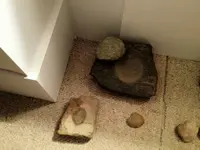
The smaller one is the nutting stone. Sorry I don't have a better pic at this time. Hope I didn't confuse any one.

The smaller one is the nutting stone. Sorry I don't have a better pic at this time. Hope I didn't confuse any one.
osage express
Sr. Member
nutting stone
it is for grinding pigments to make paint. Like red ocher berries and such.I have a few small ones my wife found in the arkansas river.Osage
What's a nutting stone?
it is for grinding pigments to make paint. Like red ocher berries and such.I have a few small ones my wife found in the arkansas river.Osage
Dark Antiquity
Greenie
- Joined
- Oct 11, 2012
- Messages
- 10
- Reaction score
- 4
- Golden Thread
- 0
- Location
- Mt Vernon, Oh
- Primary Interest:
- All Treasure Hunting
Check out omars or Omarolluk. Very easy to confuse with true Nutting or Cupstones.
pickaway
Bronze Member
- Joined
- Nov 1, 2011
- Messages
- 1,175
- Reaction score
- 952
- Golden Thread
- 0
- Detector(s) used
- ace 400
- Primary Interest:
- All Treasure Hunting
I agree natural stone...Sorry, I think it was made by mother nature. Check inside the "dimples" for use marks but I really think it is natural.
NC field hunter
Silver Member
Dark Antiquity said:Check out omars or Omarolluk. Very easy to confuse with true Nutting or Cupstones.
I have always thought that a stone for cracking nuts should have a Shallow concave spot for keeping the nut from rolling. I always thought that the stones with deep concave spots would not be for cracking nuts. Some of the "nutting stones" I have seen had holes too deep to crack a nut in. Many of them were used for grinding corn and other grain. I also think they were multifunctional tools. Many of them have cupped out spots on more than 1 face, and I have noticed that many of them have a small L shaped notch out of one corner. Any one else noticed that??
wells
Hero Member
- Joined
- Mar 1, 2008
- Messages
- 683
- Reaction score
- 561
- Golden Thread
- 0
- Location
- Middleburg, Pa.
- Primary Interest:
- Other
in the northest you can find those everyday and they are natural, not to say they were not picked up and used.
NC field hunter
Silver Member
I had no idea that that was a common work of nature in certain parts. I'm on the VA. Line, and they aren't the rarest find, but far from common. I'm glad to know that they can be natural and found in large numbers depending on location.
NC field hunter
Silver Member
Here is a couple more pics of my small nutting stone. Can any one tell me what the notch in the corner is cut out for? I have a large one with the same corner notch in it. This one is made out of poor lithic but I suppose they wanted a softer stone for some reason. Sorry for the hijacked thread.
GatorBoy
Gold Member
- Joined
- May 28, 2012
- Messages
- 14,716
- Reaction score
- 6,156
- Golden Thread
- 0
- Primary Interest:
- All Treasure Hunting
I just thought I would add something to this thread.. the natives in any one particular area almost always designated a certain type of local stone that works best for that particular job.. so if it's not found in context with other artifacts you need to first check that it is the correct type of stone for that area. like one gentlemen said he finds lots of them that are natural in the North East.. I'm sure there is nutting stones in the Northeast So in order To have any idea That what you're looking at Is an artifact or not Make sure It's the right type of stone First.
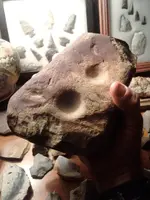
They very often Have indents on both sides.
And..NC.. I think the "notches" that you're talking about are just where another stone was used to knock off any parts that were jagged or otherwise not wanted on something that was going to be handled alot.
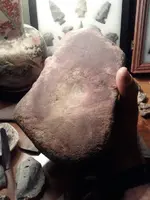 I'm not sure if it's the case with all of them but the ones I have that have indents on both sides show impact damage on one side and grinding wear on the other.
I'm not sure if it's the case with all of them but the ones I have that have indents on both sides show impact damage on one side and grinding wear on the other.

They very often Have indents on both sides.
And..NC.. I think the "notches" that you're talking about are just where another stone was used to knock off any parts that were jagged or otherwise not wanted on something that was going to be handled alot.
 I'm not sure if it's the case with all of them but the ones I have that have indents on both sides show impact damage on one side and grinding wear on the other.
I'm not sure if it's the case with all of them but the ones I have that have indents on both sides show impact damage on one side and grinding wear on the other.
Last edited:
NC field hunter
Silver Member
GatorBoy
Gold Member
- Joined
- May 28, 2012
- Messages
- 14,716
- Reaction score
- 6,156
- Golden Thread
- 0
- Primary Interest:
- All Treasure Hunting
I'm not sure of your understanding of the word context. Scattered field finds are no longer in "context" they may be in a higher probability area but have all been separated from their original resting place. to truly be in context.. an artifact needs to be still locked in its "matrix" ( the undisturbed soil that was ground level at the time the artifact wound up where is it was) in direct Association with the objects around it like a time capsule. Field finds are all out of context. They may be very numerous in some areas however they are all considered isolated finds by definition. since they are no longer in thier original resting place and no chronological story can any longer be put together by their placement. Here is an example..... If I found an archaic point next to a soda bottle that doesn't mean they were drinking Pepsi a few thousand years ago.
Last edited:
yakker
Bronze Member
Yup. Lots more in areas with constant, hard, single-direction waterflow- where a smaller rock can 'catch' in a boulder 'pocket' of sorts, start spinning around and around in an eddie until it eventually bores a hole- which can be quite deep in some cases. It will show horizontal, screwlike lines rather than impact/pounding marks. Paint cups often show residue of pigment. Nut stones (if there really is a segregated item which can be called such a thing) would be shallow enough to crack the shell of a nut w/o crushing the meat inside. There are also, I think, examples of deep mortars + pestles, but I think those are often (the mortar part) 'created' in non-mobile/permanent rock formations- out west. Just my 2 cents. HH!I had no idea that that was a common work of nature in certain parts. I'm on the VA. Line, and they aren't the rarest find, but far from common. I'm glad to know that they can be natural and found in large numbers depending on location.
Yak
Ammonhotep
Sr. Member
- Joined
- Apr 21, 2012
- Messages
- 429
- Reaction score
- 242
- Golden Thread
- 0
- Detector(s) used
- Radio Shack Lone Star, baby!
- Primary Interest:
- All Treasure Hunting
Personally, I have never seen nature do that, but, their is a lot that I haven't seen.
Where I wander (Sahara) it happens a lot. The stone gets a divot, which fills with sand. The wind swirls the sand creating a drilling action. Some stone is more prone to this type of action than others, but I've even seen holes through flint.
Here's a photo I took yesterday:
View attachment 693391
Last edited:
- #20
Thread Owner
I think they could be natural. The ones I've found are always made out of same stone. But I always find them in same area as points. Also I found same kind of stones in Iowa in fields as I did in ne SD. I could go either way. The circles are so perfect I'm sure if seen woulda been used.
Similar threads
- Replies
- 5
- Views
- 426
- Replies
- 8
- Views
- 513
Users who are viewing this thread
Total: 1 (members: 0, guests: 1)
Latest Discussions
-
-
Have you used psychics or remote viewers to find treasures?
- Latest: Knockneed Man
-
-

